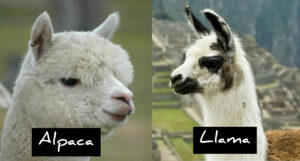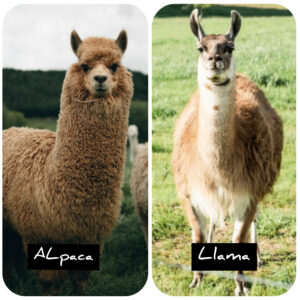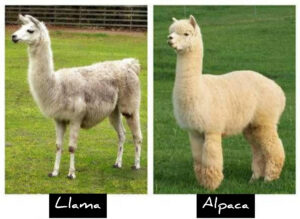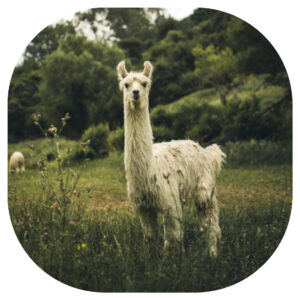The major difference between alpaca and llama is their size. Alpacas are typically smaller, standing around 36 inches at the shoulder, whereas llamas are larger, usually reaching heights of 42 to 46 inches at the shoulder.
Difference between alpaca and llama (Table)
| Characteristic | Alpaca | Llama |
|---|---|---|
| Size | Smaller, typically 5 to 5.5 feet at the shoulder | Larger, usually 5.5 to 6 feet at the shoulder |
| Ears | Shorter, spear-shaped ears | Longer, banana-shaped ears |
| Fur | Softer and finer fur, used primarily for fiber production | Coarser fur, often used as pack animals |
| Face | Flatter and more “smushed” face | Longer and more pointed face |
| Temperament | Generally more timid and shy | Often more independent and assertive |
| Primary Use | Fiber production and as companion animals | Pack animals and guardians of herds |
| Carrying Capacity | Less suited for heavy loads | Well-suited for carrying heavy loads |
| Adaptation to Altitude | Better adapted to high altitudes | Tolerate lower altitudes better |
| Social Behavior | Tend to prefer smaller herds | Often form larger social groups |
| Vocalization | Make high-pitched humming sounds | Emit a variety of vocalizations |
Alpacas and llamas belong to the same family (camelidae). Though they belong to the same family, these animals are quite different in many respects or ways. Let’s get to it, you’ll never mix them up again.
Alpaca
Alpacas are very ancient animals. They were domesticated by the Incas almost 6000 years ago. They are reared for their magnificent fleece and wool. Alpacas are slender-bodied animals.
They have long legs and necks with small ears and an almost squished mouth. Their average weight is about 60kgs and their average height coming to around 3 feet.
There are two types of alpacas in the world. Suri and Huacaya. The Suri has long fibers that are extremely silky. The Huacaya has woolly, thick, and ruffled fleece.
Alpacas come in different colors and vary from brown, white, black, tan, and grey. Alpacas are found only in central and Southern Peru and Western Bolivia.
They are limitedly distributed. This makes the demand for their fleece high. The alpacas’ fleece is exceptionally lightweight and strong. It is brilliant and luminous with high resistance to rain and snow.
Alpacas tend to live in marshy grounds with an altitude of 4000-4700 feet. They have adapted to the limited oxygen found in this region and have a high number of red blood cells.
Alpacas hum a lot. It is the most common sound they make. They hum when they are happy, inquisitive, stressed, anxious or disturbed, bored, etc.
Llama
Llama is a mammal and belongs to the same class as that of camels; camelidae (order Artiodactyla). Llamas do not have the characterized hump that camels possess.
They are lean-bodied animals. They have long necks as well as ears with short tails and a small head.
They are herbivorous animals. They feed on grass and other plants. Like cows, they regurgitate their food and eat it as cud. They don’t require a lot of water. This makes them perfect to use in rigid mountainous terrains with sparse vegetation.
When they are agitated or nervous, they spit. It helps them show dominance.
Llamas are found all over the world. Most of the packs found in South America are maintained by the Indians found in Bolivia, Peru, Ecuador, Chile, and Argentina.
They are pack animals that can be saddled with about a weight of about 70 pounds.
With such weight, they can cover a distance of about 18 miles. Llamas are disposed of animals but only till a certain point.
If the weight they are carrying is too much, they will refuse to move. Most of the time, they will lie down until the weight is reduced. Llamas will also spit if they are irritated too much.
Read also: Difference between subsistence and commercial farming
Uses of alpaca
- Alpacas are raised for their fiber, their fleece is softer, stronger and warmer (at the same weight) than sheep’s wool.
- Many people keep alpacas as companion animals due to their gentle and friendly nature.
- Alpacas are used as therapy animals to provide comfort and emotional support to individuals in various healthcare settings.
- Alpacas can serve as livestock guardians, protecting herds of other animals from predators.
- Alpacas are valuable in sustainable agriculture, as their grazing habits are less damaging to pastures compared to some other livestock.
- Their eco-friendly grazing helps maintain healthy ecosystems in the areas where they are raised.
- In the early 14th century, they were used for religious ceremonies.
- Also raised by farmers for money. Money from selling their fleece or from selling their young (Cria), and in rare cases, their meat (Viande).
Uses of llama
- Llamas are used primarily as guard animals, especially against large predators like bobcats and coyotes.
- Llamas are often employed as pack animals to carry heavy loads on treks and expeditions.
- Llamas make excellent hiking companions due to their surefootedness and ability to navigate rugged terrain.
- In therapy and animal-assisted interventions, llamas provide comfort and emotional support to individuals in need.
- Their manure is a valuable natural fertilizer, contributing to sustainable agriculture practices.
- Other than being guard animals, llamas can serve as pets they’re really good around children.
- Also serve as business for farmers as they make profit from llama sales.
Read also: Difference between monocot and dicot
Distinguishing features
- Ears
- Wool
- Face
- Size
- Purpose
- Personality
- Strength
- Character
Ears

The ears of alpacas are straight and pointed while that of the llamas are shaped like bananas. So never mix them up. You can clearly see the difference from the photo.
Fur

Llamas have no wool, they just have hairs that serve as protection and covering. On the other hand, alpacas are bred purely for their luxurious wool, which is one of the finest in the world with different beautiful colors.
The llama’s hair or fleece is coarse to feel while that of alpacas are soft and silky to feel.
Face

The face of an alpaca has more fuzz and wool than that of llama which doesn’t have much hair. Apart from the hair features, we can clearly see that llama’s got long face while and alpaca’s face is a bit more blunt, giving them a funny and unique expression.
Read also: Breeds of Turkey
Size

Llamas are bigger in size than alpacas. A mature llama can weigh from 250 to 450 pounds and grow as tall as 6feet (taller than some of us). Alpacas on the other hand have a mature weight of around 100 to 180 pounds and grow as tall as 5feet
Purpose

Llamas have been nicknamed the “ship of the Andes”. Their back are very suitable to carry heavy weights for long distances.
Alpacas on the other hand are all wool and you dare not put nothing on them, they’re too fragile for that. They literally can carry nothing, not even a baby.
Personality

Alpacas are very gentle and shy while Llamas are very confident and brave animals.
Strength

Alpacas can’t protect themselves, and need protection. Llamas are brave and can protect and will protect themselves. Often times alpacas and llamas are put together to live, so that the latter can protect the former. This is lovely.
Characters
Alpacas are very intelligent and can learn tricks. The llamas kinda seem too proud or maybe confident and arrogant for learning tricks.
Characteristics of alpacas
- Camelid Family: Alpacas are part of the camelid family, which also includes llamas, camels, and guanacos.
- Size: Alpacas are smaller than llamas, typically standing at about 5 to 5.5 feet tall at the shoulder.
- Fiber Production: They are primarily bred for their soft and luxurious fleece, which comes in various colors.
- Gentle Nature: Alpacas are known for their gentle and friendly disposition, making them suitable as companion animals.
- Quiet: They are relatively quiet animals and communicate through soft hums, clucks, and occasional alarm calls.
- Herbivores: Alpacas are strict herbivores, feeding on grasses and hay.
- Low Impact Grazers: They have a gentle grazing pattern that minimizes damage to pastures, making them suitable for sustainable agriculture.
- Lifespan: Alpacas can live up to 20 years or more with proper care.
- Reproduction: Alpacas have a gestation period of about 11 months and typically give birth to a single cria (baby alpaca) at a time.
- Cultural History: Alpacas have a rich cultural history, particularly in South America, where they have been domesticated for thousands of years for their fiber and as pack animals.
Characteristics of llamas
- They have long faces.
- Mainly used for work and can carry loads of about 45-60 kg on an average of 25-30 km travel a day.
- They hiss, spit, kick and refuse to move when stressed.
- They have camel like body shape but without the humps of the Bactrian and dromedary camel.
- 70% of llamas are found in Bolivia.
- They feed on grass and like cows, they chew it as cud.
FAQs about alpaca and llama
- Are llama and alpaca the same?
- No, llamas and alpacas are not the same. They are two different species of animals, although they both belong to the camelid family. Llamas are larger than alpacas, have distinct physical differences, and are primarily used as pack animals, while alpacas are bred for their soft fleece.
- Is a llama a camel?
- Llamas are part of the camelid family, which also includes camels, alpacas, and guanacos. While they share a common ancestry with camels, llamas are a separate species from camels.
- Do alpacas lay eggs?
- No, alpacas do not lay eggs. Alpacas, like all mammals, give birth to live young after a gestation period of about 11 months. They do not lay eggs.
- Do people eat alpacas?
- While alpacas are not commonly raised for their meat in many Western countries, they are consumed in some regions of South America. The meat is considered a source of nutrition and is used in traditional dishes in certain cultures.
- Is an alpaca a camel?
- Alpacas are part of the camelid family, similar to camels, but they are distinct species. They share common ancestry with camels but have different characteristics and are adapted to different environments.
- Do alpacas spit?
- Yes, alpacas, like llamas, can spit as a means of defense or communication. They may spit when they feel threatened, during disputes with other alpacas, or when they want to establish dominance in a social hierarchy. Spitting is a common behavior in both alpacas and llamas.
The bottom line
Alpacas and llamas are two different animals, they are of the same family (camelid) just like the guanacos and vicunas. They all have similarities, but they’re all different animals. Read the article if you missed the differences.


